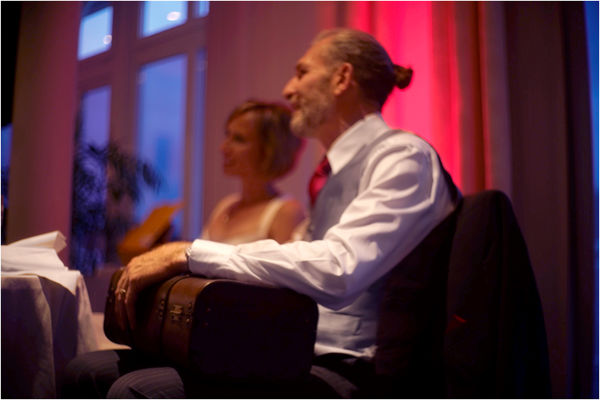raw vs jpg: a practical example
Jul 17, 2017 00:29:21 #
They say a picture is worth a thousand words, so maybe this is worth 3000...
I was shooting a wedding informally for a friend--reportage style, no posing, no flash. I normally shoot only raw, but I was shooting raw+jpg to have easily accessible viewing files. Admittedly, this is a difficult situation. We have mixed lighting and high contrast. WB was set for daylight I guess, and this was clearly under tungsten. Clearly results would have been different had I bet set to tungsten, but this does demonstrate the strengths of shooting raw.
Adjusting white balance is NOT the same with raw and jpg. Raw files contain all possible white balances, because all chroma information is present and the three color channels (RGB) can be accessed and adjusted separately. On the other hand jpgs, in post processing, can only have an overall color wash applied in R, G and B. Aside from the extra dynamic range accessible in raw, this is the most important reason to shoot raw.
The first photo is the scene as shot. The second photo is a quick WB adjustment done with the raw file.
Now we come to trying to adjust the jpg. Because the color wash is applied to all luminance values, it proves to be impossible to create a natural white balance. If I try to create the same whites as seen in the highlights of the shirt in the raw adjustment, the skin tones turn much too florid (as seen in example 3). Adjusting instead the skin tones to a more natural hue results in very yellowish highlights. Notice that in neither example are the neutral greys of the clothing actually neutral. Welcome to jpg world...
Admittedly, for more minor adjustments, jpgs can be made to look pretty good, but you hit up against the limits fairly quickly. For anyone serious about obtaining the best possible image quality, I think this demonstrates graphically why shooting raw is worth the trouble.
I was shooting a wedding informally for a friend--reportage style, no posing, no flash. I normally shoot only raw, but I was shooting raw+jpg to have easily accessible viewing files. Admittedly, this is a difficult situation. We have mixed lighting and high contrast. WB was set for daylight I guess, and this was clearly under tungsten. Clearly results would have been different had I bet set to tungsten, but this does demonstrate the strengths of shooting raw.
Adjusting white balance is NOT the same with raw and jpg. Raw files contain all possible white balances, because all chroma information is present and the three color channels (RGB) can be accessed and adjusted separately. On the other hand jpgs, in post processing, can only have an overall color wash applied in R, G and B. Aside from the extra dynamic range accessible in raw, this is the most important reason to shoot raw.
The first photo is the scene as shot. The second photo is a quick WB adjustment done with the raw file.
Now we come to trying to adjust the jpg. Because the color wash is applied to all luminance values, it proves to be impossible to create a natural white balance. If I try to create the same whites as seen in the highlights of the shirt in the raw adjustment, the skin tones turn much too florid (as seen in example 3). Adjusting instead the skin tones to a more natural hue results in very yellowish highlights. Notice that in neither example are the neutral greys of the clothing actually neutral. Welcome to jpg world...
Admittedly, for more minor adjustments, jpgs can be made to look pretty good, but you hit up against the limits fairly quickly. For anyone serious about obtaining the best possible image quality, I think this demonstrates graphically why shooting raw is worth the trouble.
scene as shot, exposed for highlights
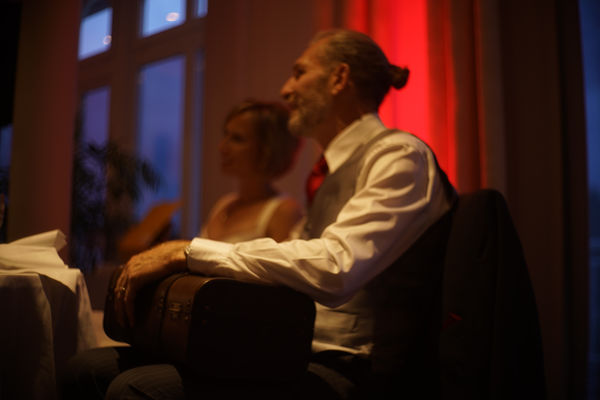
(Download)
RAW adjustment done in PS (ACR)
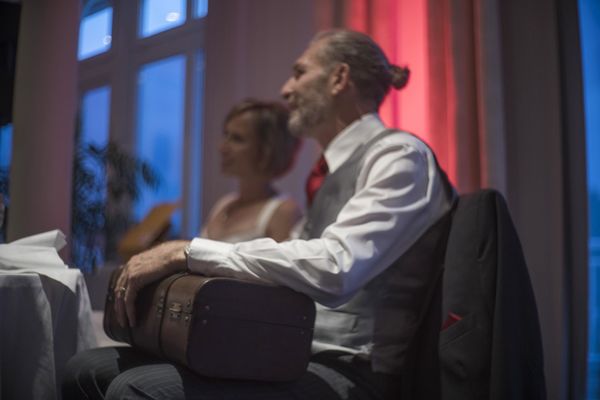
(Download)
attempt at jpg white balance--trying to create neutral white highlights, resulting in an overall magenta cast
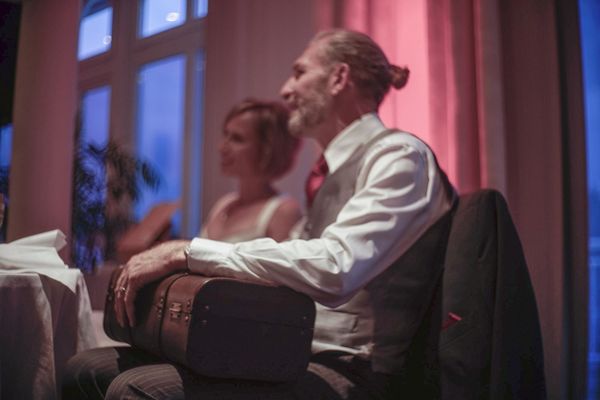
(Download)
attempt 2 at jpg white balance--trying to get a natural skin tone, resulting in yellowish highlights
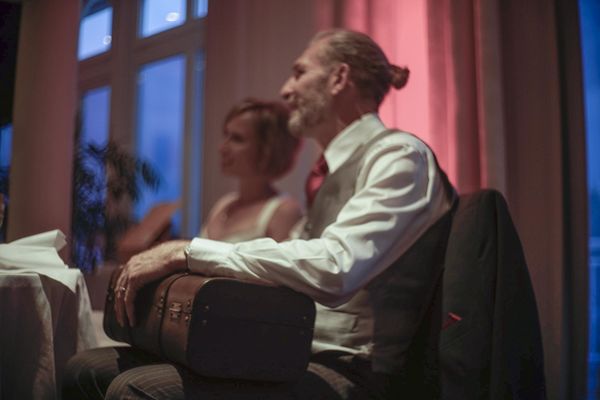
(Download)
Jul 17, 2017 01:24:00 #
wdross
Loc: Castle Rock, Colorado
Thanks for the demo. This just tells me that I need to be sure to get software that will process RAW when I finally upgrade my computer. My computer is too small to store most software. I'm thinking of getting an external drive to store my programs and clearing out my small computer of most programs. Then I can call them up from the external drive as I need them.
Jul 17, 2017 11:15:34 #
kymarto wrote:
They say a picture is worth a thousand words, so m... (show quote)
I like this demo. However, if the correct white balance had been originally applied, the jpeg would be much closer to your RAW adjusted file.
Jul 17, 2017 12:02:51 #
Jim Bob wrote:
I like this demo. However, if the correct white balance had been originally applied, the jpeg would be much closer to your RAW adjusted file.
Of course that is true, but that wasn't the point of the demo.
Jul 17, 2017 19:19:39 #
kymarto wrote:
Of course that is true, but that wasn't the point of the demo.
Oh really? Read your last sentence and then tell me that my comment is not a reasonable interpretation of the demo's purpose.
Jul 17, 2017 20:55:56 #
The point was to show that post WB adjustment for jpg and raw rely on different mechanisms, and that raw is much more flexible than jpg--as flexible as the camera in fact. Of course I said that the difference would be less if the camera's WB were set more neutrally in this demo. That is clear. But the range of WB adjustment--keeping the same tint across shadows, mids and highlights, is always going to be more limited in a jpg, which has thrown away a huge amount of chroma info (and luma info too) as compared to a raw file.
Jul 18, 2017 07:02:34 #
kymarto wrote:
The point was to show that post WB adjustment for ... (show quote)
I definitely agree with your last statement.
Jul 18, 2017 08:05:48 #
Jul 18, 2017 08:13:27 #
cdayton wrote:
I hate to bring this up, but they are all pretty bad.
As demo material they are spot on.
Jul 18, 2017 09:33:32 #
cdayton wrote:
I hate to bring this up, but they are all pretty bad.
Indeed they are. The point is that some day you might have a technically poor photo that you want to salvage because of its content (not this one, but it could happen), and you'll be a lot better off if it was shot in raw. Another point to consider is that if you are moving between lighting situations, shooting in raw means that you never have to stop and set the white balance, because you can set it just as well in post without any loss of quality. In fast moving situations that can mean the difference between getting the shot or not. Generally speaking I leave my camera on AWB just so I am in the ballpark for viewing, and then tune it up at my leisure afterwards.
For this wedding I shot about 1000 frames in raw+jpg. It took me about five hours to choose two hundred (raws) and post-process them, then turn them into presentable jpgs for the couple. I will also send them the full set of jpgs, in case they want something worked on that I didn't choose in the two hundred. To be clear here: I am a photojournalist, not a wedding photographer, so this whole event was shot in reportage style without any posing, no flash, nothing. I was in a very high contrast situation, and so shooting in raw gave me a lot of latitude to tweak the shadows and highlights (shooting with a Sony A7Rii with 14 stops of DR). If I were a standard wedding photographer doing standard coverage, it wouldn't much matter if I were shooting raw or jpg. I wanted latitude, both for reasons of speed, color and latitude, and that is why I shot raw.
Jul 18, 2017 09:38:54 #
Jul 18, 2017 09:45:11 #
kymarto wrote:
Indeed they are. The point is that some day you mi... (show quote)
I thank you for the great explanation and demo !!
Willie
Jul 18, 2017 11:42:48 #
I understand your point and it's most valid if you only use Lightroom. But this is what you can do with your original JPEG in Photoshop if you have an extra 2 minutes.
kymarto wrote:
They say a picture is worth a thousand words, so m... (show quote)
Jul 18, 2017 11:54:52 #
Fotoartist wrote:
I understand your point and it's most valid if you only use Lightroom. But this is what you can do with your original JPEG in Photoshop if you have an extra 2 minutes.
What planet is the girl from ??
Or is that a sunburn ...
Jul 18, 2017 11:58:38 #
Fotoartist wrote:
I understand your point and it's most valid if you only use Lightroom. But this is what you can do with your original JPEG in Photoshop if you have an extra 2 minutes.
Interesting, but I consider the skin tones much less accurate than what the OP submitted as his processed RAW file.
If you want to reply, then register here. Registration is free and your account is created instantly, so you can post right away.






